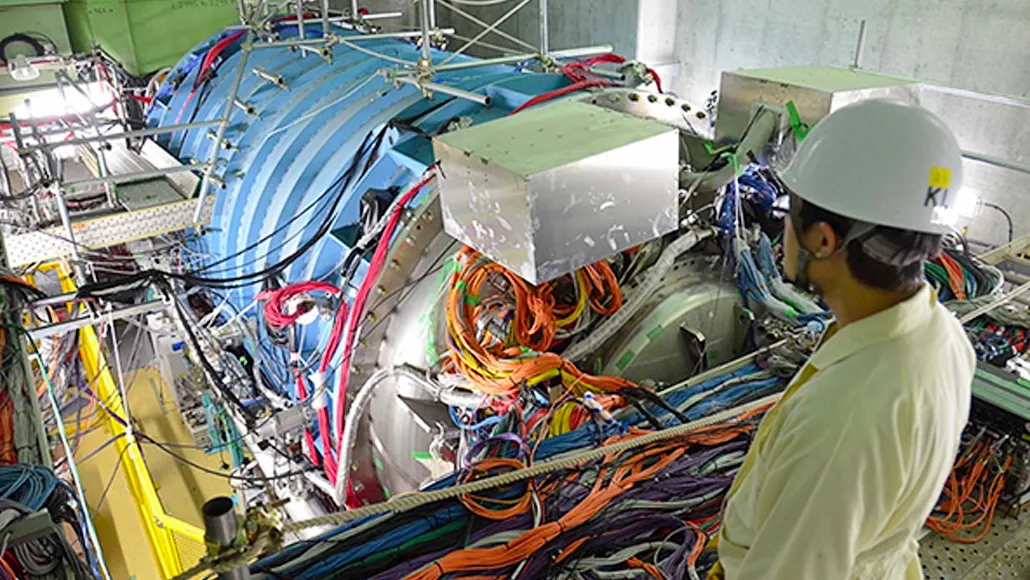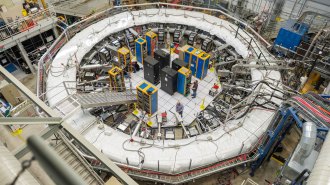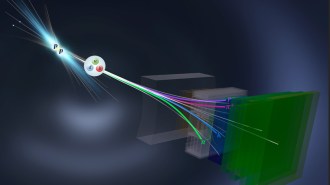Misbehaving kaons could hint at the existence of new particles
Certain extremely rare decays seem to be happening more often than expected

New subatomic particles could explain a surprisingly large number of decays of particles called kaons seen in the KOTO experiment (detector shown).
Japan Proton Accelerator Research Complex (J-PARC) Center
- More than 2 years ago
A little-known type of particle called a kaon may be stepping into the spotlight.
The exotic subatomic particles are attracting attention for their unexpected behavior in an experiment at a Japanese particle accelerator. Rare kaon decays seem to be happening more frequently than expected, according to the KOTO experiment. If the result holds up to further scrutiny, it could hint at never-before-seen particles that would dethrone particle physicists’ reigning theory, the standard model.
There’s still a good chance KOTO’s result will be overturned, says Yuval Grossman of Cornell University. But “there’s the extremely exciting possibility that they see something totally new.”
The standard model describes the particles and forces that underpin the universe. But there are still puzzles to solve, such as why there’s more matter than antimatter in the universe (SN: 11/25/19). So physicists are leaving no stone — or kaon — unturned in efforts to test the theory. One realm subject to scrutiny is very rare decays of kaons. The standard model predicts precisely how rare those decays are, and KOTO, based at the Japan Proton Accelerator Research Complex in Tokai, was built to test that prediction.
According to the standard model, KOTO should have seen only a fraction of a decay, on average, over a few years’ worth of data. But last September, at the International Conference on Kaon Physics in Perugia, Italy, researchers from KOTO preliminarily reported a bounty of four potential decays.
“It’s hair-raising for sure,” says physicist Yau Wah of the University of Chicago, co-spokesperson of KOTO. But particle physics experiments are notorious for spurious signals that can mimic real particles (SN: 8/5/16). Additional studies must be done before claiming the decays are real, Wah says.
That hasn’t stopped physicists from considering implications. Already, a flurry of scientific papers have proposed explanations for the anomaly.
KOTO is searching for a particular decay of a kaon into three other particles. One of those particles, a pion, produces light that KOTO detects. The other two, a neutrino and an antineutrino, sail through the detector without a blip. That means KOTO is looking for a specific signature: one pion and nothing else. One possible explanation for the four decays is that the kaon might be decaying into a pion plus a new type of particle that, like neutrinos, leaves no trace. That scenario would reproduce the one-pion signature KOTO is searching for, and might happen more often, explaining the extra decays.
But there’s a catch. KOTO studies kaons that have no electric charge, but other experiments studying charged kaons see no anomaly. That discrepancy is difficult to explain: If the new particle really existed, it should show up for both types of kaons.
Still, there are ways around this problem, physicist Teppei Kitahara and colleagues report in a paper accepted in Physical Review Letters. For example, the differing sizes of kaon experiments could be part of the answer. At just a few meters long, “KOTO is very small” compared with other kaon experiments, says Kitahara, of Nagoya University in Japan. “This means unstable new particles can easily escape the detector.”
In a larger detector, it’s harder for particles to escape unobserved. The new particle could decay into other particles that could be spotted, so that the one-pion signature of decaying kaons wouldn’t be reproduced. That could explain why KOTO sees excess decays but other experiments don’t.
Problems arise not only in the particles’ potential escape from laboratory apparatuses, but also from exploding stars, or supernovas, which could produce the new particles. If those particles escape a supernova, they would carry energy with them. But that energy loss would muck up the known energy budget of supernovas, making some explanations for the kaon decays untenable, physicist Bhupal Dev of Washington University in St. Louis and colleagues report November 27 at arXiv.org. So Dev and colleagues propose a particle that would be trapped inside supernovas by its interactions with other particles.
Scientists are also considering potential connections to other physics puzzles. For example, experimental measurements disagree with predictions for the magnetic properties of electron-like particles called muons (SN: 9/19/18). “If you want to explain this … you need a model beyond the standard model,” says physicist Xiaoping Wang of Argonne National Laboratory in Lemont, Ill. She and colleagues have come up with a hypothetical particle that could simultaneously explain the muon conundrum and the unexpected kaon decays, the team reports January 17 at arXiv.org.
While Grossman is skeptical that KOTO’s result will stand, he admits that, deep down, he hopes it is real. “When you go to totally unexplored territory, you always have to be ready for surprises.”







